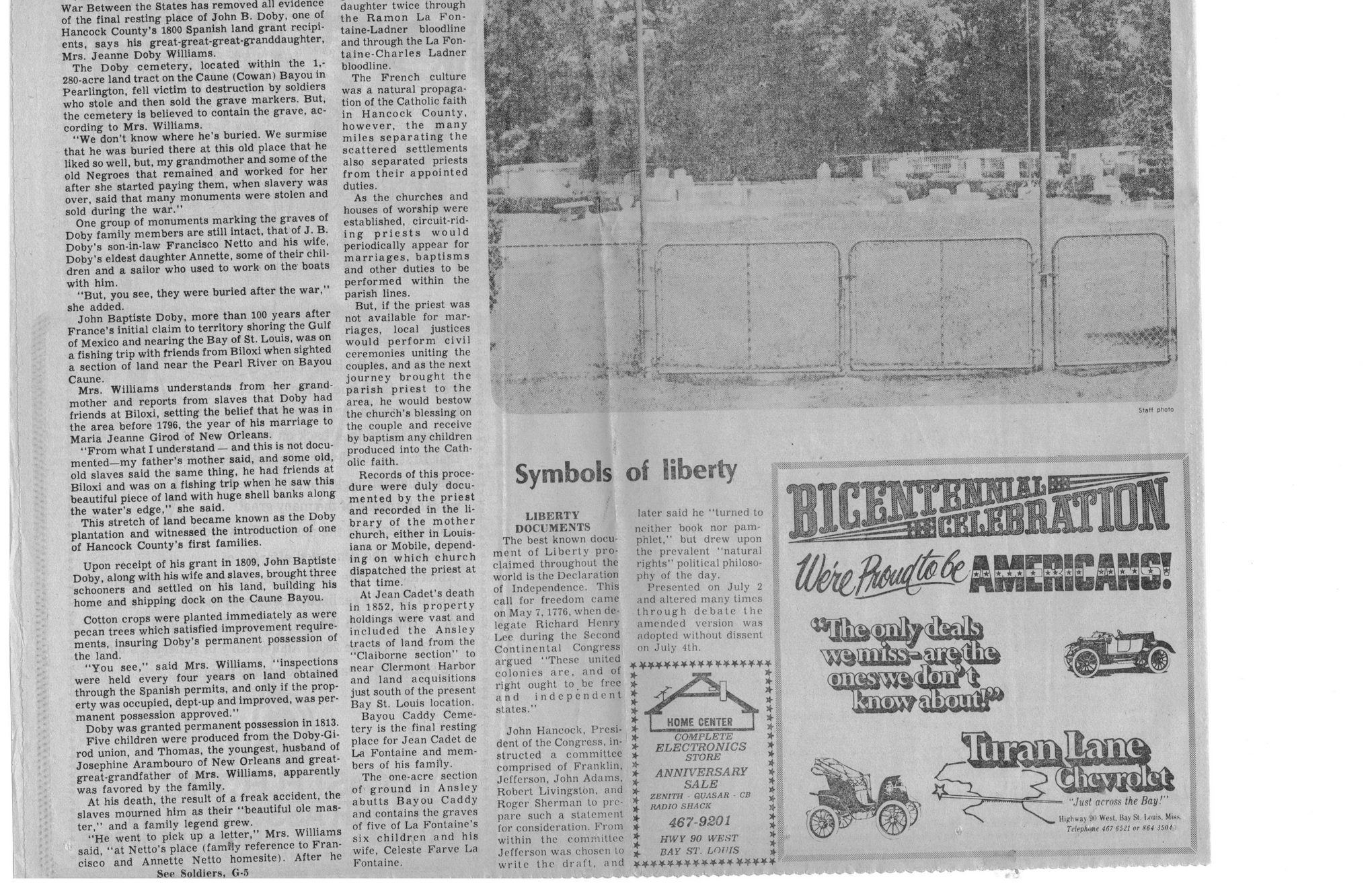This text was obtained via automated optical character recognition.
It has not been edited and may therefore contain several errors.
War Between the States has removed all evidence of the final resting place of John B. Doby, one of Hancock County’s 1800 Spanish land grant recipients, says his great-great-great-granddaughter, Mrs. Jeanne Doby Williams. The Doby cemetery, located within the 1,-280-acre land tract on the Caune (Cowan) Bayou in Pearlington, fell victim to destruction by soldiers who stole and then sold the grave markers. But, the cemetery is believed to contain the grave, according to Mrs. Williams. “We don’t know where he’s buried. We surmise that he was buried there at this old place that he liked so well, but, my grandmother and some of the old Negroes that remained and worked for her after she started paying them, when slavery was over, said that many monuments were stolen and sold during the war.” One group of monuments marking the graves of Doby family members are still intact, that of J. B. Doby’s son-in-law Francisco Netto and his wife, Doby’s eldest daughter Annette, some of their children and a sailor who used to work on the boats with him. “But, you see, they were buried after the war,” she added. John Baptiste Doby, more than 100 years after France’s initial claim to territory shoring the Gulf of Mexico and nearing the Bay of St. Louis, was on a fishing trip with friends from Biloxi when sighted a section of land near the Pearl River on Bayou Caune. Mrs. Williams understands from her grandmother and reports from slaves that Doby had friends at Biloxi, setting the belief that he was in the area before 1796, the year of his marriage to Maria Jeanne Girod of New Orleans. "From what I understand — and this is not documented—my father’s mother said, and some old, old slaves said the same thing, he had friends at Biloxi and was on a fishing trip when he saw this beautiful piece of land with huge shell banks along the water’s edge,” she said. This stretch of land became known as the Doby plantation and witnessed the introduction of one of Hancock County’s first families. Upon receipt of his grant in 1809, John Baptiste Doby, along with his wife and slaves, brought three schooners and settled on his land, building his home and shipping dock on the Caune Bayou. Cotton crops were planted immediately as were pecan trees which satisfied improvement requirements, insuring Doby’s permanent possession of the land. “You see,” said Mrs. Williams, “inspections were held every four years on land obtained through the Spanish permits, and only if the property was occupied, dept-up and improved, was permanent possession approved.” Doby was granted permanent possession in 1813. Five children were produced from the Doby-Gi-rod union, and Thomas, the youngest, husband of Josephine Arambouro of New Orleans and great-great-grandfather of Mrs. Williams, apparently was favored by the family. At his death, the result of a freak accident, the slaves mourned him as their “beautiful ole master," and a family legend grew. “He went to pick up a letter,” Mrs. Williams said, "at Netto’s place (famfly reference to Francisco and Annette Netto homesite). After he See Soldiers, G-5 daughter twice through the Ramon La Fon-taine-Ladner bloodline and through the La Fon-taine-Charles Ladner bloodline. The French culture was a natural propagation of the Catholic faith in Hancock County, however, the many miles separating the scattered settlements also separated priests from their appointed duties. As the churches and houses of worship were established, circuit-rid-ing priests would periodically appear for marriages, baptisms and other duties to be performed within the parish lines. But, if the priest was not available for marriages, local justices would perform civil ceremonies uniting the couples, and as the next journey brought the parish priest to the area, he would bestow the church’s blessing on the couple and receive by baptism any children produced into the Catholic faith. Records of this procedure were duly documented by the priest and recorded in the library of the mother church, either in Louisiana or Mobile, depending on which church dispatched the priest at that time. At Jean Cadet's death in 1852, his property holdings were vast and included the Ansley tracts of land from the “Claiborne section" to near Clermont Harbor and land acquisitions just south of the present Bay St. Louis location. Bayou Caddy Cemetery is the final resting place for Jean Cadet de La Fontaine and members of his family. The one-acre section of ground in Ansley abutts Bayou Caddy and contains the graves of five of La Fontaine’s six children and his wife, Celeste Farve La Fontaine. Staff photo Symbols of liberty LIBERTY DOCUMENTS The best known document of Liberty proclaimed throughout the world is the Declaration of Independence. This call for freedom came on May 7, 1776, when delegate Richard Henry Lee during the Second Continental Congress argued “These united colonies arc, and of right ought to be free and independent states.” John Hancock, President of the Congress, instructed a committee comprised of Franklin, Jefferson, John Adams, Robert Livingston, and Roger Sherman to prepare such a statement for consideration. From within the committee Jefferson was chosen to write the draft, and later said he “turned to neither book nor pamphlet,” but drew upon the prevalent “natural rights” political philosophy of the day. Presented on July 2 and altered many times through debate the amended version was adopted without dissent on July 4th. ***************** * * ' * * *; *? * *; *■: *; * us COMPLETE ELECTRONICS STORE ANNIVERSARY SALE ZENITH QUASAR CB RADIO SHACK 467-9201 HWY 90 WEST BAY ST. LOUIS ''.lust across the Bay!" Hi(;hwa> 90 West. Ba> St. Liuis. Miss Trlfphunc 467 6521 or #64 1504 ************ *****

BSL 1970 To 1976 Newspaper-Clippings-BSL-'70-'76-(13)